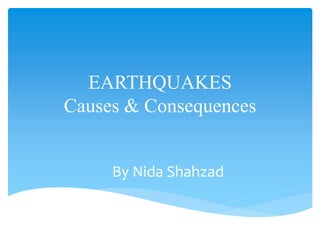
Causes & Consequences of Deadly Earthquakes
- 1. EARTHQUAKES Causes & Consequences By Nida Shahzad
- 2. Earthquakes Types of Earthquakes Anatomy of Earthquakes Causes of Earthquakes Waves of Earthquakes Seismograph & Richter Scale Distribution of Earthquakes World Deadliest Earthquakes Earthquakes in Pakistan Effects of Earthquakes Contents
- 3. It is the release of Internal Stress of Lithosphere Shaking of Earth Crust Earthquakes are also termed as Creep, Seismic Slip or it may be Elastic Rebound depending upon the nature of Movement Earthquakes
- 4. With the sudden displacement and associated stress release, the rocks snap back elastically to their previous dimensions, this behavior is called Elastic Rebound. Elastic Rebound
- 5. When movement along fault occur gradually and smoothly it is called Creep It is also called Seismic Slip Seismic Slip
- 6. Generally there are following types of Earthquakes depending upon their depth a. Shallow Focus Earthquakes <70km b. Mid Focus Earthquakes 70-300km c. Deep Focus Earthquakes 300- upto 700km On the basis of Magnitude Earthquakes can be classify as a. Micro-Earthquakes b. Macro-Earthquakes Types of Earthquakes
- 7. Foreshocks Epicenter Hypocenter/Focus After Shocks Magnitude a. Richter Scale Intensity a. Mercalli Intensity Scale Anatomy of Earthquakes
- 8. Earthquakes are generally occurs due to the Plate Movements or due to the Faults 90 percent of the world's earthquakes occur along plate boundaries The rocks are usually weaker and yield more readily to stress Causes of Earthquakes
- 9. Convergent Plate Boundaries Divergent Plate Boundaries Transform Plate Boundaries Plate Boundaries
- 11. Faults Fault is a fracture or zone of fractures between two blocks of rock Faults allow the blocks to move relative to each other This movement may occur rapidly, in the form of an earthquake - or may occur slowly, in the form of creep Faults may range in length from a few millimeters to thousands of kilometers. Normal Fault (Vertical Displacement due to Tension) Fault Scrap (Steep, Straight Cliff like Feature) Reverse and Overthrust Faults
- 12. There are 3 basic types of faults 1. Dip-Slip Fault 2. Strike-Slip Fault 3. Oblique-Slip Fault Types of Faults
- 14. 1. Dip-slip faults are inclined fractures where the blocks have mostly shifted vertically. If the rock mass above an inclined fault moves down, the fault is termed normal, whereas if the rock above the fault moves up, the fault is termed reverse. A thrust fault is a reverse fault with a dip of 45 degrees or less. Oblique-slip faults have significant components of different slip styles. 2. Strike-slip faults are vertical (or nearly vertical) fractures where the blocks have mostly moved horizontally. If the block opposite an observer looking across the fault moves to the right, the slip style is termed right lateral; if the block moves to the left, the motion is termed left lateral.
- 15. Seismic energy travels through the crust in the form of waves The propagation velocity of seismic waves depends upon the density and elasticity of the medium in which seismic waves are penetrated Seismic Waves are of two types a) Body Waves b) Surface Waves Waves of Earthquakes
- 16. A body wave is a seismic wave that moves through the interior of the earth P and S waves are Body Waves Each type of wave shakes the ground in different ways Body Waves
- 17. P-Waves can travel through gases, solids and liquids P-waves are produced by earthquakes and recorded by seismometers The name P-wave stands either for Primary Wave P-Waves has the highest velocity and is therefore the first to be recorded It is a longitudinal wave and motion is parallel to direction of propagation P-Waves
- 18. Like P-Waves they are high frequency, short-wavelength waves But instead of being longitudinal they are transverse On the surface of the Earth, S-Waves are responsible for the sideways displacement S-waves move like waves in a rope S-Waves
- 19. Travel near the surface Surface Waves are of following types Rayleigh Waves Love Waves The combination of Rayleigh and Love Waves results in ground heave and swaying buildings Surface waves cause the most devastating damage to buildings, bridges, and highways Surface Waves
- 20. These instruments are used to measure the magnitude of the Earthquake The seismograph consists of a seismometer (the detector) and a recording device Richter Scale was developed by Charles F.Richter in 1935 It measures the magnitude of the earthquakes Seismograph & Richter Scale
- 21. 90 percent of the world's earthquakes occur along plate boundaries 47% of major earthquakes occur within 100 miles of a convergent plate boundary 71% of major earthquakes occur within 200 miles of a convergent plate boundary Distribution of Earthquakes
- 22. 1. Shensi, China, Jan. 23, 1556 2. Tangshan, China, July 27, 1976 3. Aleppo, Syria, Aug. 9, 1138 4. Sumatra, Indonesia, Dec. 26, 2004 5. Haiti, Jan 12, 2010 6. Damghan, Iran, Dec. 22, 856 7. Haiyuan, Ningxia , China, Dec. 16, 1920 8. Ardabil, Iran, March. 23, 893 9. Kanto, Japan, Sept. 1, 1923 10. Ashgabat, Turkmenistan, Oct. 5, 1948 World Deadliest Earthquakes
- 23. 1. Quetta 1935 2. Pasni 1945 3. Gilgit, Hazra and Sawat Valley 1974 4. Muzaffarabad 2005 5. Baluchistan 2008 Earthquakes in Pakistan